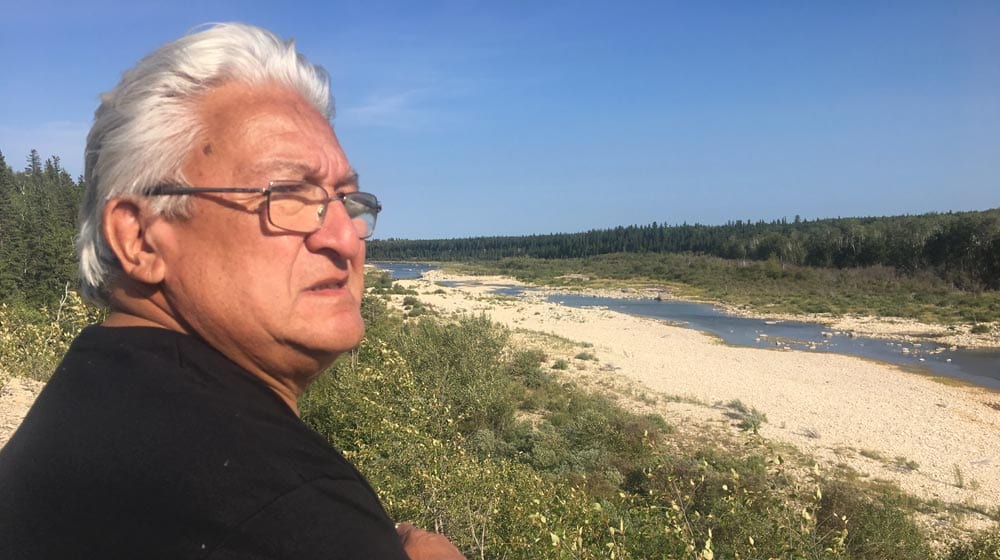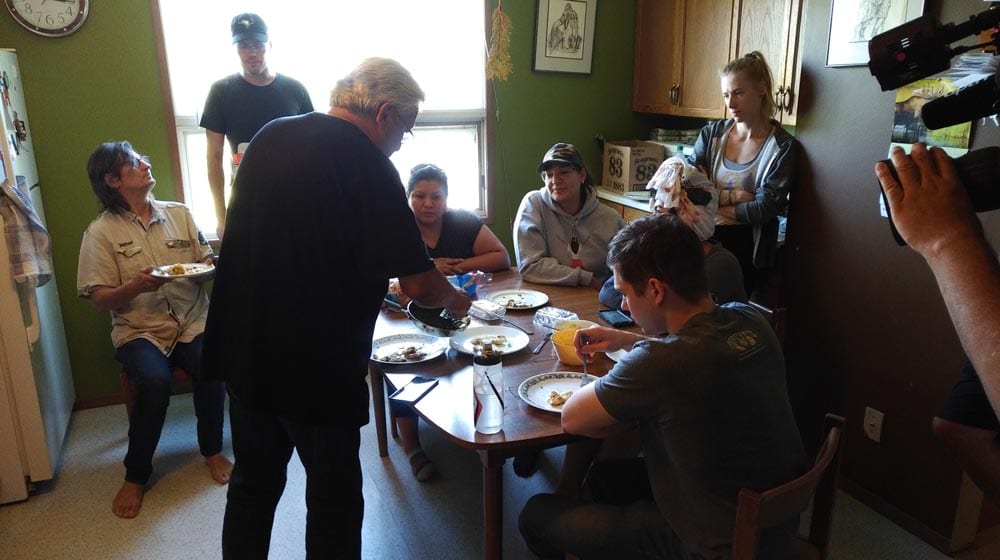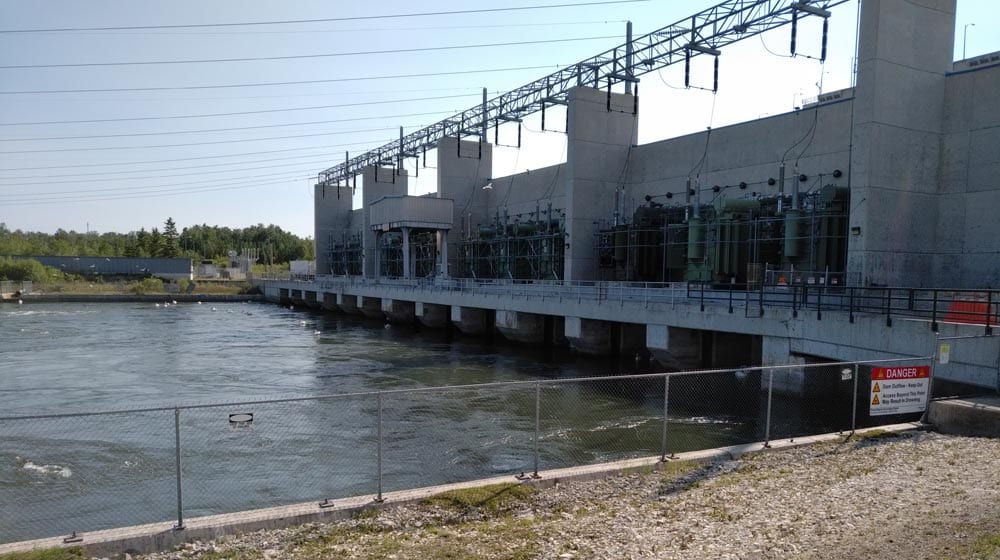By Justin Brake and Ashley Brandson
Originally published on September 18th, 2018 in APTN News
Rays of sunlight peek through the trees and illuminate two dozen wooden crosses hidden in a small patch of bush surrounded by the desolate rocky landscape of an abandoned quarry.
Gerald McKay of Misipawistik Cree Nation examines a necklace someone has appended to a tree. He holds the cross pendant at the end of the chain and says he’d never noticed it before.
McKay, 63, is leading a small group on a tour of the land below a large hydroelectric dam just outside the town of Grand Rapids, the community widely regarded as the gateway to northern Manitoba.
It’s the first stop on a week-long visit to Cree communities in Treaty 5 territory by members of the Wa Ni Ska Tan hydro alliance.
Along the way they’re picking up elders and other members of hydro-impacted communities and bringing them to other communities to bear witness and share stories of how their livelihoods and way of life have been altered by the network of hydro dams on their waterways.
Today, the graves they’re visiting belong to the ancestors of McKay’s community.
The wooden crosses were erected in 2001, more than three decades after Manitoba Hydro excavated the area to build a dyke for the Grand Rapids generating station, one of the first major dams built in northern Manitoba.
McKay says the graves would have been bulldozed had one of the workers not been a local man.
“They started to dig up bones and they weren’t going to stop… so the local guy stopped them and they shut the whole job down,” he says, explaining work eventually resumed with the small parcel of land being protected as crews continued to excavate all around it.
Now the gravesite exists as a small island of trees surrounded by a desert of blasted rock and a dried up riverbed.
The Grand Rapids dam came online in 1968 and was the first hydro facility built in Northern Manitoba to power the provincial electricity system.
At the end of the dirt road where McKay lives is a dilapidated playground, and beyond that a small grassy knoll and a steep embankment down to the water.
(Gerald McKay along the shores of the once mighty Grand Rapids. Photo: Justin Brake/APTN)
From the shoreline you can see the spillway of the 479-megawatt structure embedded in the dyke — gigantic even in the distance and accentuated by countless seagulls and pelicans in the air and on the water below.
The group later stands atop that dyke, which runs more than 25 kilometres along the shore of Cedar Lake. They peer out at the lake’s vast waters, the levels of which are now controlled by Manitoba Hydro.
Communities along the shores of Cedar Lake were impacted by the flooding. The people of Chemawawin First Nation were forced to relocate to Easterville.
And the people of Moose Lake, Cormorant and The Pas all share stories of devastation to their hunting, fishing and trapping economies, and to their way of life.
The power now contained in the force of the water against the Grand Rapids dyke is unnatural, human-made — a power once represented by the roaring sound of the rapids, which McKay says you could hear from the community.
Below the dyke are the rocks that once belonged to those rapids on the lower Saskatchewan River. About a kilometre downstream the river empties into Lake Winnipeg, the eleventh largest freshwater lake in the world.
Now, there’s barely a trickle of the once “grand” rapids, and a scattered pool of still water.
“The old rapids is gone,” McKay says, pointing down at the riverbed. He explains that’s how the town of Grand Rapids “lost its name.”
“It’s just Grand. There is no more rapids — so even the name was reshaped. Most of the animals are gone, most of the fish are gone, and that’s the new reality I guess.”
Residential schools and hydro development a “double whammy” for Cree
One of the researchers along for the trip is Ramona Neckoway, from Nisichawayasihk Cree Nation at Nelson House and an assistant professor in Aboriginal and Northern Studies at University College of the North in Thompson, Man.
Neckoway has been involved with Wa Ni Ska Tan since its inception in 2015.
Hydro development in Treaty 5 is personal for her.
(Ramona Neckoway, right, with Gerald McKay. Photo: Ashley Brandson/APTN News)
On the drive from Winnipeg to Misipawistik, the Cree mother and grandmother tells APTN News that hydro development in northern Manitoba is more than the consequences of any one specific impact.
She says it’s bigger.
“For me this is a cultural genocide that’s going on. And I don’t use those words lightly. I say that because I see that there are entire generations of children in our communities that don’t go on the water, that don’t understand the importance of that water to who we are, that have never left the reserve, this cage that they’ve created through colonial policies that have been imposed on us,” she says.
“To me, Nisichawayasihk, our territory actually is much bigger than the reserve that they allotted to us. And we were using that territory—my mother’s generation was using that territory, going to camps, going to these different spaces and actively using that land and that water.”
Neckoway tells APTN News that over the next week we’re going to see, and grow to understand, the cumulative impacts on her people, their way of life, and on their identity.
The violence perpetrated against Indigenous women during the construction of hydro dams is nothing new to the Cree.
Sexual abuse of women in Fox Lake Cree Nation in the 1960s recently grabbed national attention, following the release of a report from Manitoba’s Clean Environment Commission.
Since that report was released, two separate investigations are underway to look into allegations of assault and sexual abuse by employees of Manitoba Hydro and members of the RCMP in communities in northern Manitoba.
Details of the allegations were made public in August when the CEC released a report on the effects of a series of hydro dams on the Nelson, Burntwood, and Churchill river systems.
The case was referred to the Independent Investigation Unit (IIU), Manitoba’s police watchdog, and the Ontario Provincial Police (OPP) by the RCMP.
A Sept. 14 release from the RCMP said the IIU will investigate the actions of RCMP officers in the region, while the OPP will investigate allegations against Manitoba Hydro employees and contractors.
The investigation is limited to the Gillam region, but Neckoway, who has been interviewing members of hydro-impacted communities since 2004, says she has “heard stories of that nature” from women in other places, though she doesn’t know how prevalent violence against women is as it’s not the focus of her research.
“We’re the caregivers, we’re the life givers, and the givers of treaty,” she says, explaining she would like to see Wa Ni Ska Tan host a women’s gathering “to start talking about a lot of the issues that are unique and specific to women.”
Neckoway says the disruption to her people’s lives can be seen in the faces of the elders when she speaks to them.
“They come alive in those moments when they talk about that connection with the land and the way that it was,” she explains. “And I see that in my grandmother when I hear her talking about it. She acknowledges that it was a hard life, but it was fulfilling and it was good at that time.
“She saw these changes in the community and became so far away I think from some of the values that we have as Cree people in this last 40 years.”
Neckoway says by comparison “you can just see the sadness when they talk about hydro, and they talk about residential school.”
She says the Cree in Northern Manitoba got a “double-whammy” in the mid-20th century.
“We got residential schools, and then, boom — the hydro projects.”
“You only cried once”
At his house in Grand Rapids, McKay fries fresh whitefish from Lake Winnipeg for the group of about eight researchers, artists, activists.
Standing at his kitchen stove he seems eager to share his stories as he sprinkles lemon pepper seasoning on the fillets.
(Gerald McKay serving fish at his home in Grand Rapids. Photo: Ashley Brandson/APTN News)
Every minute or two he flips them with a plastic spatula.
At the same time, McKay’s frequent pauses hint at a pain that comes with reliving traumatic experiences.
In the 1960s, when McKay was just a child, thousands of workers flooded the community to build the dam.
He says it’s the experiences from that time that drive him to continue fighting for justice for his people and community today, a half century later.
McKay says the quiet community was turned upside down overnight.
There was racism.
School buses would pick up white kids but leave Cree and Metis kids standing on the side of the road, he says.
“In the wintertime that was the hardest,” he recalls. “And you only cried once, when you were walking from here to the school. You didn’t cry twice, because your eyes would freeze shut.”
He recalls a story of a Cree family whose baby boy was sick and needed medical care.
“They took him to the hospital up there, then they looked at him and sent him home, and they went back and they sent him home again,” he says. “So they took him the third time and he died. He died in the hospital.”
McKay says when the family arrived back at the hospital, their son’s body was given back to them in cardboard box.
He describes “perverts” and “peeping toms” roaming the community at night.
McKay says at one point his mother, a young woman at the time, caught someone trying to steal McKay’s baby sister right out of a bedroom in their home.
“She was less than a month old and they cut the screen, and they were reaching in to take her, and my mother caught them,” he recalls. “So nothing was ever done about that. There was no investigation, nothing, because there wasn’t enough cops here.”
McKay says that after the incident his mother “nailed the windows shut for three years” and often wouldn’t let him and his siblings leave the yard.
(The Grand Rapids Hydroelectric dam. Photo: Ashley Brandson/APTN News)
Meanwhile, the dam’s impact on the local land-based economy — primarily fishing and trapping — put McKay’s father out of work.
“His jobs disappeared — one was flooded, the other one there was no more spawning, so once you caught all the fish it started to drop off,” he explains.
“In 1969, I think there was mercury in the fish and hydro denied that it was them and then they shut fishing down and there was no compensation for anybody. We all depended on my dad’s income to eat, and we couldn’t eat the fish anymore. That’s just the way it was and so my generation would remember all that stuff, but there’s kids growing up now that have no idea what was here before.
“A lot of people say get over it — like, it’s already happened. Well, just because it already happened doesn’t mean it’s not an injustice.”
Money in exchange for a way of life
In 1991 Misipawistik Cree Nation — Grand Rapids Cree Nation at the time — signed an agreement with Manitoba Hydro worth just over $5 million.
It was one of five settlements reached in the early ‘90s associated with the impacts on Cree and Metis communities. Together they totalled just under $32 million.
In 2005, after serving as national chief for the Assembly of First Nations, Ovide Mercredi was elected chief of his home community of Misipawistik.
That fall, amid concerns from community members that once the Grand Rapids spillway was opened new brush that had grown downstream would end up in the water, Mercredi and Grand Rapids Mayor Robert Buck camped out on the dried riverbed below the spillway in protest.
In 2015, Manitoba Hydro was required to apply for a renewal of its 50-year operating licence for the Grand Rapids dam, a fact that gave Mercredi and Buck’s protest power.
As they gained support from their own community and others, people in Winnipeg began paying attention.
Manitoba Hydro CEO Bob Brennan paid them a visit — as did then premier Garry Doer.
Doer committed to new negotiations with Misipawistik, and in 2012 a settlement agreement was reached — though its details remain secret.
APTN requested interviews with Misipawistik Chief Harold Turner—who was also chief at the time of the community’s 1991 agreement with Hydro—and Mercredi. Neither responded by the time of publication.
However, APTN obtained a draft of the agreement in which the First Nation’s compensation is contingent on Misipawistik’s “active support” of Manitoba Hydro’s application for the 50-year operating license renewal, and on Hydro’s success in obtaining the renewal.
According to the draft agreement, Misipawistik would receive a retroactive payment of $3 million, a $5 million payment on the signing of the deal, $800,000 a year for 50 years indexed to inflation, and a lump sum payment of $10 million in year 50, which would be 2061.
But according to Misipawistik councillor Heidi Cook, the agreement will see the band receive a flat payment of $1-million a year for the duration of the contract that Hydro calls a “friendship agreement.”
The agreement has not been made public by the band or Manitoba Hydro.
McKay says the deal is “not as good as it sounds” and that the people of the community “don’t feel it.”
Little has changed
With somewhere between 800 and 1,000 members living on reserve and another 800 off-reserve, Misipawistik Cree Nation is no better off in the long run following the 2012 agreement than it was before, says McKay.
He claims community members received a one-time $500 payment after the band signed the agreement, and get about $120 every three years.
But the money hasn’t eradicated the racism, or the poverty.
McKay drives us through the neighbourhoods, once thriving with a healthy subsistence economy where Cree and Metis coexisted as one community.
Since Hydro moved in, however, racism and inequality have taken root, their manifestations visible.
On the south side of the water is the Misipawistic reserve, occupied primarily by the descendants of the region’s original Cree inhabitants. Many houses are overcrowded, McKay says, and badly in need of repair.
On the north side is what’s now the residential area of the municipality of Grand Rapids, a mix of Metis, non-status Cree and settlers.
And then, just a few hundred metres north of Grand Rapids, toward the hydro dam, a small suburban-like neighbourhood of Manitoba Hydro workers — many of them living in homes built by Manitoba Hydro.
McKay points out the “hydro houses,” as he calls them, have two metres measuring energy consumption.
One, he says, measures the energy used to heat the homes—comprising the bulk of household energy usage, especially in the colder months—and another to measure other electricity usage.
“Hydro pays for the heating bill,” McKay says.
Meanwhile, many in the community struggle to pay their own hydro bills, he says.
The sense of injustice in his community is palpable, McKay explains — but to a shrinking number of people since youth today don’t recognize what their parents and grandparents experienced and lost, he says.
(Gerald McKay at the dam in his community. McKay worked for Manitoba Hydro for four years. Photo: Ashley Brandson/APTN News)
He says the 1991 and 2012 compensation agreements don’t take into account the loss of his people’s way of life.
“An agreement should be fair for both sides, not just one side,” he says.
“They should take into account, how many graves were lost? How many people were put out of work with the fishery? We’ve lost our language — how much is that worth?”
But the money hasn’t restored his people’s way of life, and McKay fears that way of life may soon be forgotten.
Cook agrees.
The 38-year-old councillor is also a mother, and someone who grew up not knowing her community’s full history until her 20s.
She says hydro development “had a bigger impact” on her people and community than residential schools, because most children would eventually come home from the schools.
“But here with the hydro dam our home was destroyed.”
Cook says her generation and the one before her have suffered as a consequence.
“Our way of life was destroyed,” she says, explaining the influx of thousands of non-Cree workers to the community contributed to the loss of their language and their ability to go out on the land.
She says her aunt and other elders in the community talk about what life was like when they could hear the rapids.
“The sound of the rapids lots of people describe as being able to be heard from miles around. And to [listen for them to] know your way back to home. As a constant, subconscious thing, a constant in your life, to know where you are.”
She says the rapids were “first replaced with explosions and the sound of heavy machinery,” while the dam was being built.
“And then with silence.”
She says elders have described “having recurring nightmares from the changes that were occurring on the landscapes.”
The impacts are inter-generational, she explains.
“I felt it myself, personally, that as somebody from Grand Rapids I was robbed of my birthright to know these rapids and to have this beautiful part of my home sing me to sleep at night, and greet me in the morning when I wake up.”
Once a Hydro employee himself, McKay returned to fishing about 20 years ago, both to honour his father and ancestors and just to be out on the water.
“Basically you’re just fishing to get EI — it’s not a good future,” he says. “My dad told me that a long time ago: there’s no future in fishing. But I wanted to be a fisherman because to me it was exciting — you never know what you’re going to catch.”
McKay worked in a Hydro control room in Grand Rapids for four years, “and it was boring,” he says.
He’s a certified project manager and has a business diploma, “but I still managed to come back to fishing,” he explains, serving up a new batch of fried fish to his visitors.
But the fishing is not what it once was.
“Last winter was the first time they ever shut down the commercial fishing season, because there’s no fish,” he says, adding the people of his community.”
Cook says a new generation in her community is fighting to get back what she and McKay’s generations lost.
“We’re not sitting here crying over what was lost without actively trying to stand up against and move forward from there,” she says adding there are land-based education and language programs in the community.
“We didn’t get to where we are overnight, and we won’t get to where we want to be overnight. But we haven’t completely lost sight of where we need to be.”
Most of the money from Misipawistik’s “friendship agreement” with Hydro is being used to address social and economic needs, primarily housing, Cook explains.
In a statement to APTN, Manitoba Hydro says it will “continue to address the adverse effects of our existing operations on the customs, practices and traditions of Indigenous people integral to their cultural identity.”
But it did not say how it is addressing these effects and did not grant APTN’s request for an interview.
“As far as their lawyers are concerned, Hydro has met its obligations and is contributing to the community through the relationship agreement,” says Cook.
Just a few years after the Grand Rapids dam came online the second wave of hydro development began, and the story of how the Misipawistik people began to lose their way of life would become a common reality throughout Treaty 5.
For more, click here: Power Failure: The impacts of hydro in Northern Manitoba
jbrake@aptn.ca
@justinbrakenews
abrandson@aptn.ca
@ashleybrandson








